Introduction
- There are 9 ranks (or rates) in the U.S. navy.
- Each of them defines a pay grade.
- They are arranged in the order of seniority.
The United States Navy has nine rates for each type of recruit. They are all assigned a number and a letter, such as E-1, E-2, E-3, and so on. Each of them corresponds to a pay grade, starting from the lowest at E-1 and the highest at E-9. The first three assignments are called “rates” as sailors in those grades are “considered to be in apprenticeships” (United States Navy, 2006). Recruits in each paygrade are assigned to different groups, each of which has its identification rate marks (stripes). All the ranks above E-4 are considered to be non-commissioned officers and carry specific sleeve.

Apprenticeship ratings: E1-E3
- Divided into 5 groups based on occupational choice: Seaman, Fireman, Airman, Constructionman, Hospitalman.
- Titles change with each rank, as E1 and E2 add the words “recruit” and “apprentice” to the group name.
- E1 has no insignia while E2 and E3 have two and three stripes on their sleeves.
In the three apprenticeship ratings, the names and responsibilities are defined by experience and seniority. Typically, all enlisted personnel start as a recruit and moves ranks gradually, gaining the necessary skills and expertise to execute different commands. Ratings E-1 through E-3 are divided into five groups engaging in various activities in the military, such as seaman, fireman, airman, constructionman, and hospitalman. The respective grades receive varying identification marks, from no insignia for recruits to three stripes for those listed in E-3 (United States Navy, 2006).
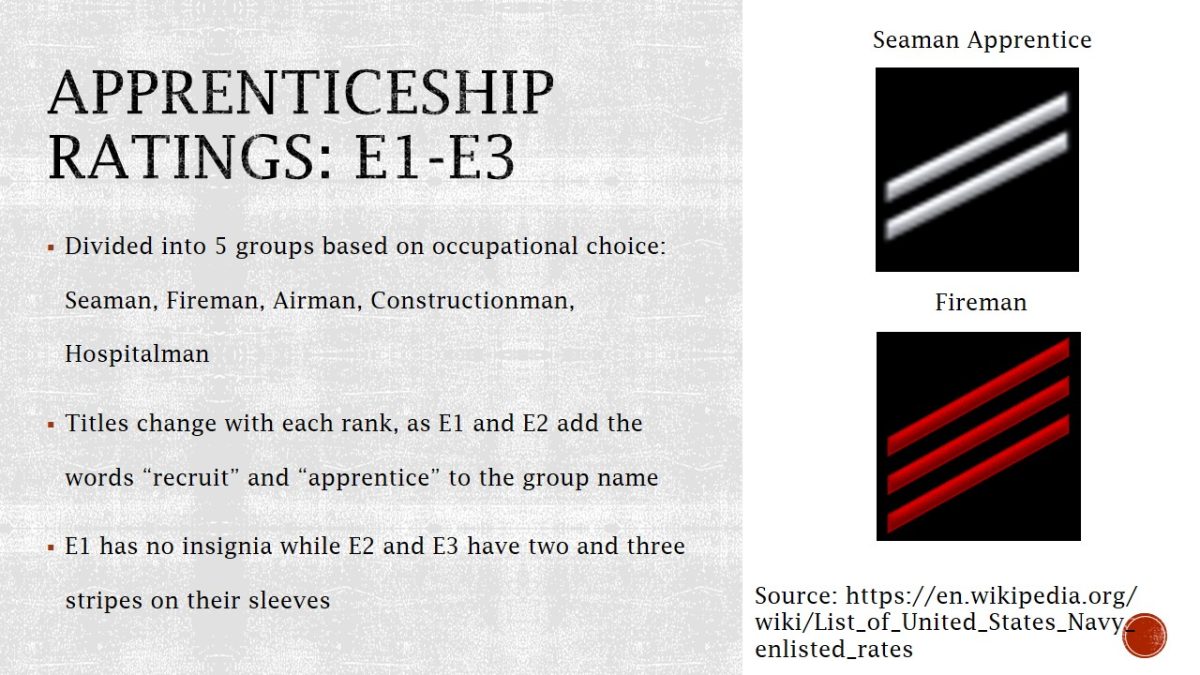
Non-commissioned officers: E4-E6
- Established in 1841, formalized by 1894.
- Different insignias : a spread-winged eagle atop a chevron.
- Number of chevrons increases with rank.
- Supervisors and technical leaders.
The title of a non-commissioned officer (NCO) first appeared in 1841 but was not formally developed until 1894 with the definition of the uniform and attached insignias. In contrast with the first three ratings, the NCOs have an eagle with spread wings atop a chevron as their individual mark. Similarly, the number of chevrons increases rank progression. For the most part, NCOs serve as first-order supervisors and technical leaders to the grades below (Naval Historical Center, 2006).
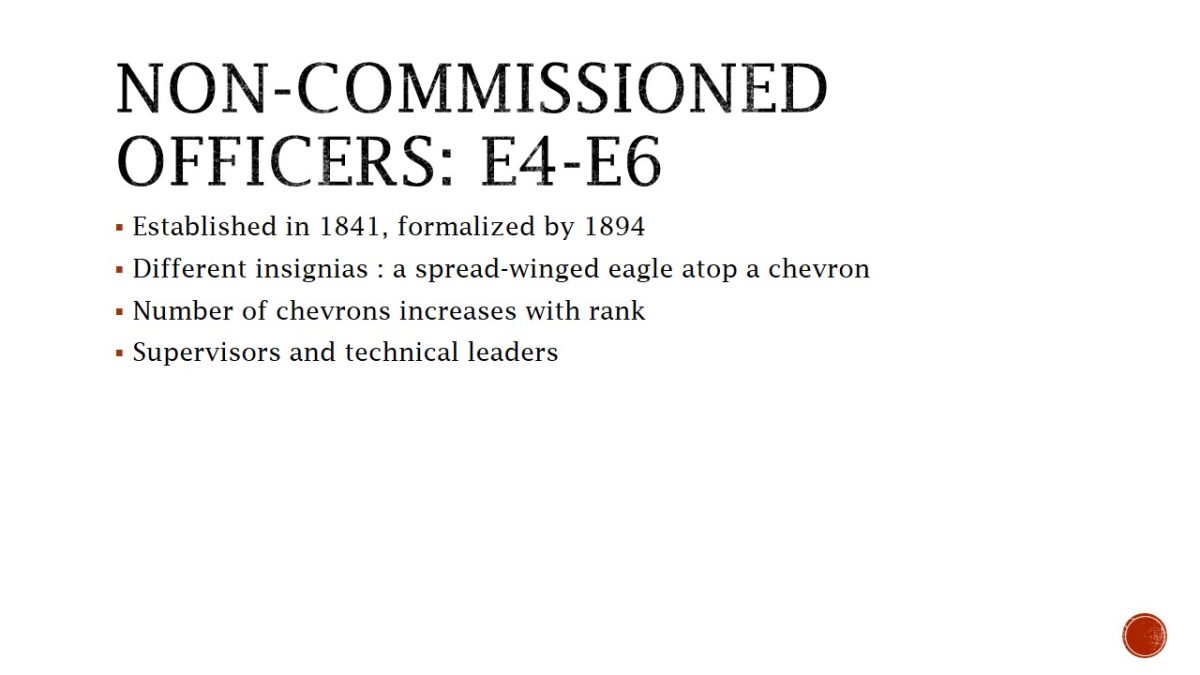
Officer ranks: CPO
- Established on April 1, 1893.
- Chief Petty Officers (CPO) belong to the 7th paygrade (E-7).
- CPOs are known as “deckplate leaders” for their placement between officers and junior enlisted.
- The Military Pay Act of 1958 established ranks E8 and E9 for all branches of the U.S. Armed Forces (United States Navy, 2018).
- The first CPO promotion was granted to 57 sailors in 1893.
- The rank received its first female chief in 1917.
- Chiefs are vital to the Navy: two minesweeper ships have been named after the grade (United States Navy, 2018).
The rank of the CPO was established in 1893 and was the highest in U.S. Navy and Coast Guard until 1958. The Military Pay Act introduced two new grades for the entirety of the U.S. Armed Forces (United States Navy, n.d.a). A CPO receives their rank for the time in service, higher evaluation ratings, specialty exams, and the peer review responsibility (Cutler, 2012).
Becoming a CPO is considered to be of the highest achievement in the U.S. Navy. Only 57 sailors were promoted when the grade was formed in 1893. On average, officers require at least 13 years of active service to join the ranks of CPOs. This comes with unique responsibilities and privileges; sometimes, chiefs are described as “servant leaders” as they “act as the liaison to commissioned officers and mentor both” (United States Navy, n.d.a).
The first woman to be promoted to the chief was Loretta Walsh in 1917. The unique responsibilities of CPOs in the Navy explain why two minesweeper ships were titled “USS Chief” (United States Navy, n.d.a).

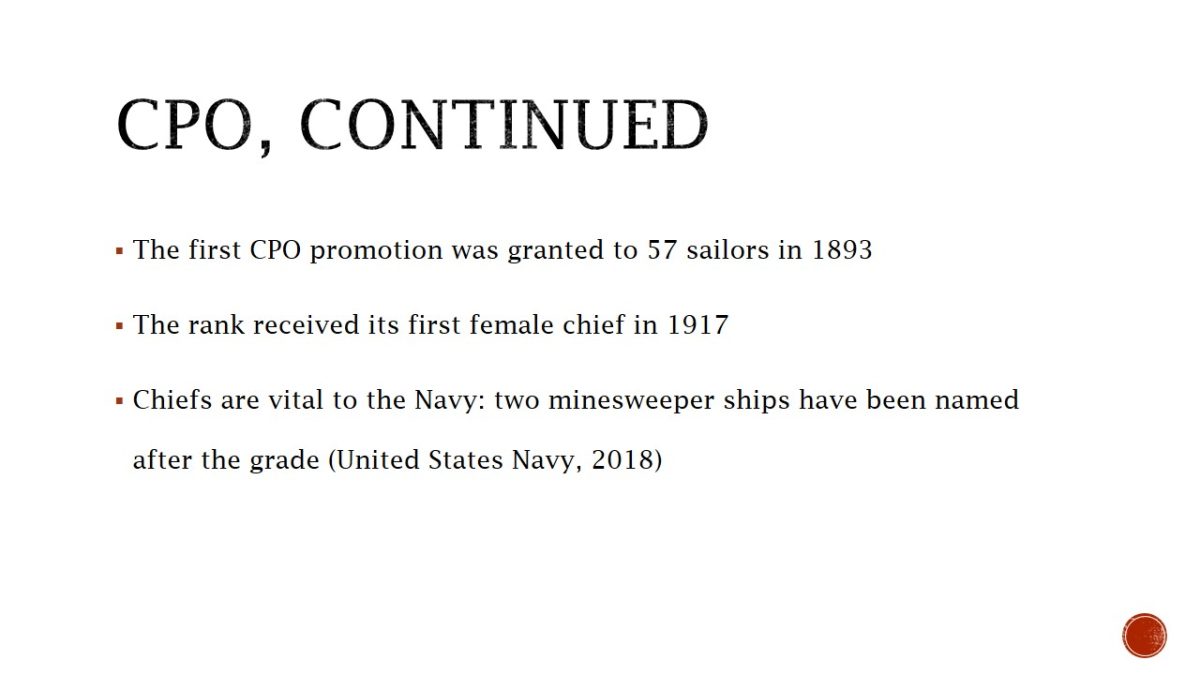
Senior Chief Petty Officer
- Established in 1958, abbreviated as E-8.
- Assist and mentor CPOs.
- Require at least 4 years of experience and board of master chiefs approval.
- Comprise 2.5% of total enlisted Navy forces.
Senior Chief Petty officers comprise only about 2.5% of all enlisted members of the navy (Mass Communication Specialist 1st Class Daniel Garas, 2015). They attain this rank after serving at least four years as CPOs and require the board of master chiefs approval. In addition to their responsibilities as CPOs, they become liable for assisting and providing guidance to the rank below (Chief of Naval Personnel, 2015).
The identification marks for those ranked E-8 include an inverted star above a spread-winged eagle atop a rating mark crowning three chevrons on the sleeve insignia and the fouled anchor on the cap device.
In 2015, the Navy formally created the rating of a command senior chief that is responsible for overseeing the health, job satisfaction, and welfare of the enlisted personnel in the command (Mass Communication Specialist 1st Class Daniel Garas, 2015).

Officer Ranks: MCPO
- Established in 1958 and abbreviated as E-9.
- Top 1.25% of all enlisted maritime forces.
- Have a service time, performance, and board review requirements.
- Have rating-specific abbreviations (FCCM, STSCM, others).
- Most commonly referred to as “Master Chief”.
Master Chief Petty Officer is the highest rank of the US Navy. It is given to the technical experts in their fields based on their time in service, performance, and board review evaluations. MCPOs constitute only 1.25% of all enlisted maritime forces (Cornell Law Institute, n.d.).
The grade was established in 1958 following the Military Pay Act. All grades have abbreviated names, such as FCCM for “fire controlman chief master”, but it is most common to refer to MCPOs as “Master Chief” (Cutler, 2012).
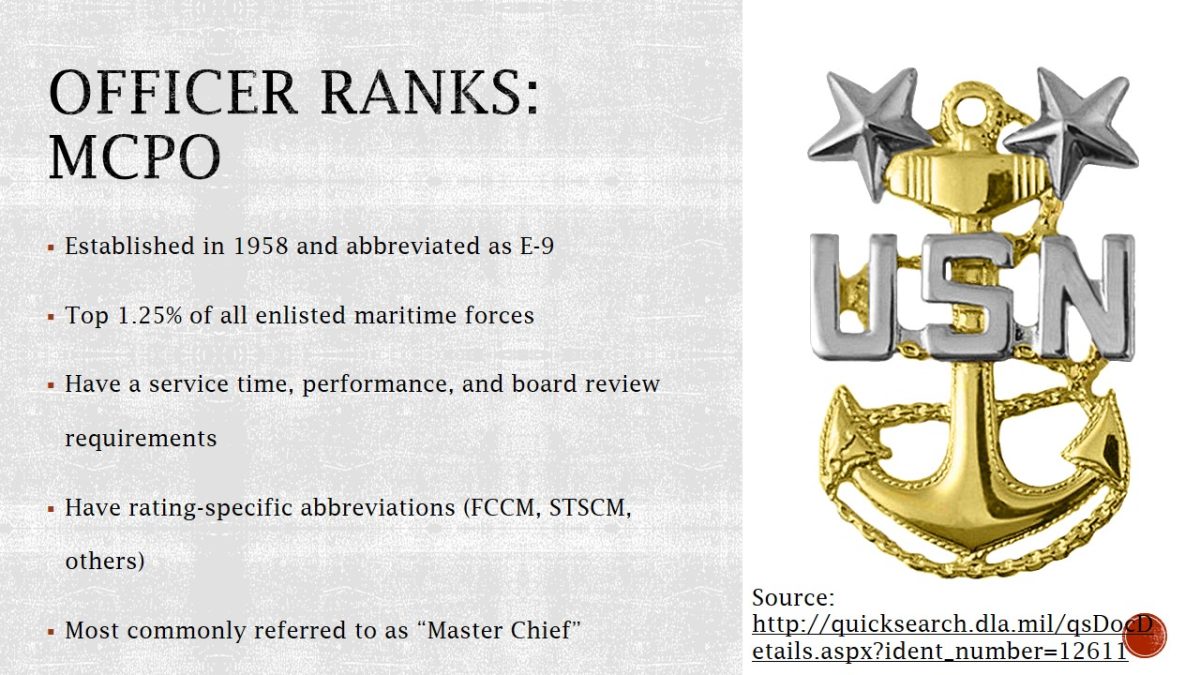
Master Chief Petty officer of the navy
- Formed in 1967; MCPON is the senior most person in the Navy.
- Advises the Chief of Naval Operations and Chief of Naval Personnel.
- Overlooks boards dealing with issues regarding enlisted personnel.
- Represents the Department of the Navy at formal events and in front of the Congress.
The Master Chief Petty Officer of the Navy is a special position within the ranks of the US Armed Forces. It was formed in 1967 as a response to a large volume of complaints from then enlisted sailors. Both in the Navy and the Coast Guard, the enlisted MCPON or MCPOCG is formally regarded as the head of the respective department and oversees personnel-related issues. On top of that, the MCPON is responsible for advising Chief of Naval Operations and Personnel, as well as to represent the Department of the Navy at formal events and in front of the Congress (United States Navy, n.d.b). Currently, the position is fulfilled by Russell L. Smith (United States Navy, n.d.c).
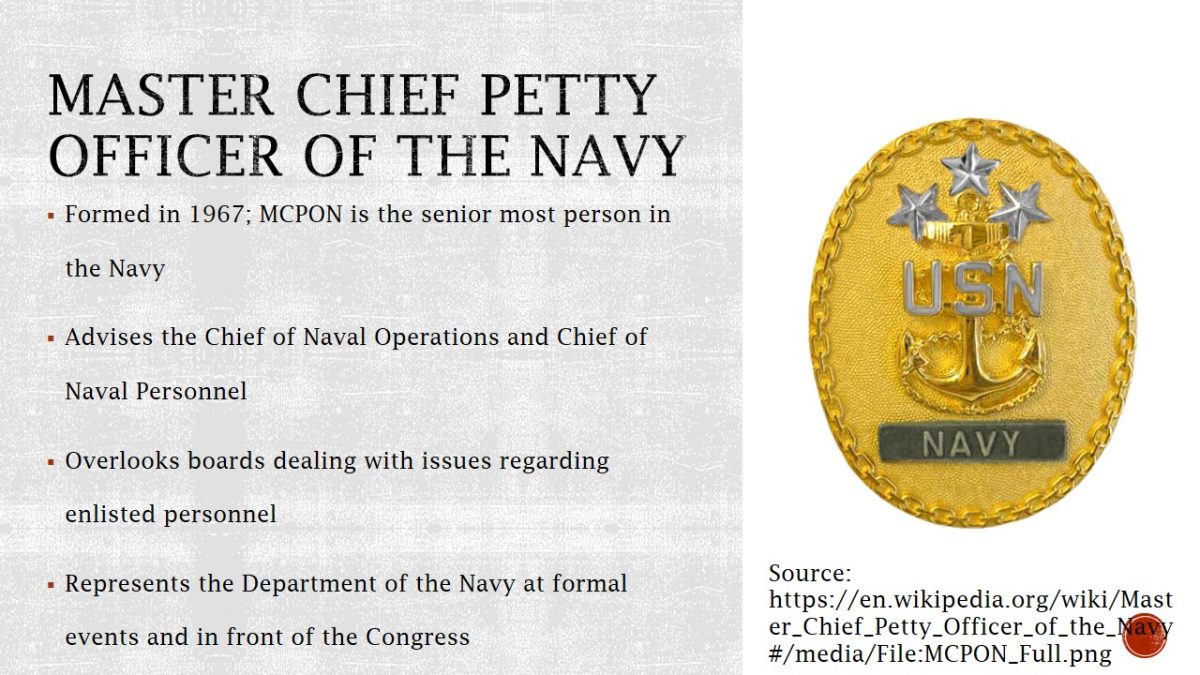
References
Chief of Naval Personnel. (2015). Navy announces command Senior Chief Rating. United States Navy. Web.
Cornell Law School. (n.d.) 10 U.S. Code § 517. Authorized daily average: members in pay grades E–8 and E–9. Web.
Cutler, T. (2012). The citizen’s guide to the U.S. Navy. Annapolis, MD: Naval Institute Press.
Mass Communication Specialist 1st Class Daniel Garas. (2015). Silent professionals: History of the rank of Chief Petty Officer. Web.
Naval Historical Center. (2006). Why is the colonel called “kernal“? The origin of the ranks and rank insignia now used by the United States Armed Forces. Web.